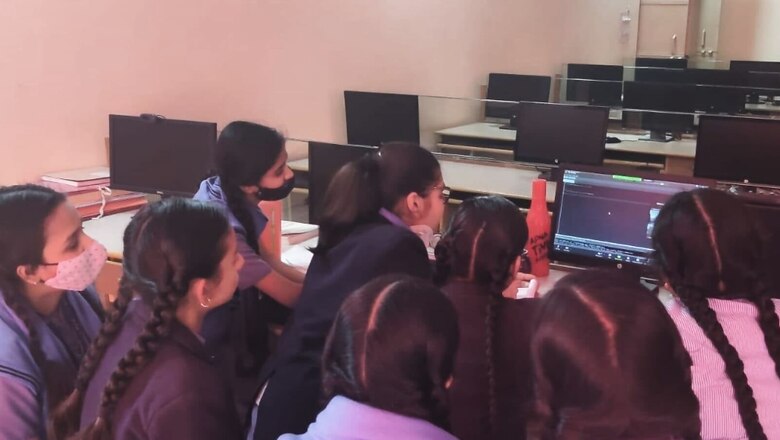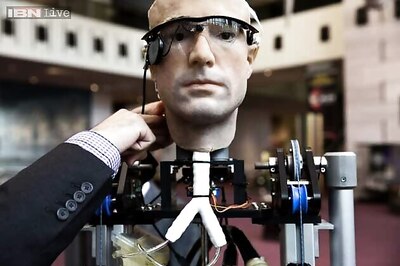
views
“Someone joked the girls were going to the moon,” laughs Kirti Mudgal, Physics teacher recalling the day, the team of 10 girl students from a school based in Raman Reti Vrindavan left for Sriharikota. “It is for the first time that the girls were getting an opportunity to watch the space launch. There was so much excitement, and wishes were pouring in from across quarters.”
Hundreds of girls from 75 schools across states reached the island off the Andhra Pradesh coast to watch India’s first Small Satellite Launch Vehicle (SSLV) take off on Sunday morning. The 120 tonne-rocket especially designed by the Indian Space Research Organisation (ISRO) for ready-to-launch commercial missions would inject two experimental satellites into low earth orbit – EOS-02 and a microsatellite – AzaadiSAT.
A PROUD MOMENT
For 14 years old Siddhi Gaikwad from New English School in Kolhar Budruk, Maharashtra, it was a moment of great pride. Her father works as a labourer, and it is for the first time she is getting to travel so far. “I’m the first girl in my family to sit on a plane, and come so far. Parivaar ki pehli ladki huun. Bahut khushi hai,” she says over the phone from Mumbai, from where the school team boarded the flight to Chennai.
Brimming with curiosity, Siddhi, who mainly converses in Marathi, has already prepared the questions she plans to ask the scientists at ISRO. The preparations had been on since the day ISRO announced the launch date for the mission, and wishes had started pouring from all quarters. “Ghar pe itne logon ne wish kiya, jitni birthday par wishes nai aati,” quips in her classmate, Avanti Yogesh Waditake, excitement palpable in her voice, “Ye itna bda mauka hai.’’
For the last six months, this all-girls team from 75 schools has been working on developing 75 payloads in their school laboratories amid challenges posed by internet issues, and closures due to pandemic. Students were provided with Arduino kits, and taught coding through online classes, and support of their teachers. The final output was then sent to Chennai-based Space Kidz India whose team fine-tuned, tested, and integrated the payloads into AzaadiSAT. The 8 kg microsatellite built was selected to mark the launch of India’s 75 years of independence.
BREAKING BARRIER
While it proved to be a dream-like opportunity for most students, some of their classmates eventually could not join, after their families did not let them travel so far. Out of the 10 girls selected for the project from her school, Pritha Aggarwal, a class 11th student from Haryana’s Ambala district was among the only two who could make it.
Elaborating on her experience of working on the space project, she says, “We learnt coding for the first time. The kit provided to us by Space Kidz India was very new. But we learnt a lot along the way, how sensors work, programming on computers. We now know how satellites actually function. There were online classes, and practical sessions that we attended apart from our regular classes, which helped us complete the project.”
Many of these students already had access to Atal Tinkering Laboratories in schools, which helped them get a start, shares Shobha Dhiman, one of the teachers from Ambala, speaking to News18 from the train. “But it was still a new, and challenging experience for both the teachers as well as the students. So many other students wanted to be a part of the project, but only 10 were selected.”
WAITING IN ANTICIPATION
On Saturday, hours ahead of the launch scheduled at 9:18 am on Sunday, majority of the students were still travelling in trains. The scheduled plan was to reach Chennai at night, and depart for the launch site before the break of dawn.
The enthusiasm was palpable, but so was the nervousness. Talking over the phone, Anushka Gupta, a Class 10 student from Agra sums it all up, “It is our satellite, the rocket is new, we really hope that all goes well and communication is established. It will be a new achievement for us to see something that we helped create, finally reach its destination in space.”
If all goes as planned, the SSLV will separate from EOS-02 — the experimental earth imaging satellite 12.3 minutes after its scheduled launch from Satish Dhawan Space in Sriharikota at 9:18 am. Exactly a minute later, at an altitude of 356 km from earth, it will part with AzaadiSAT which will get injected into the Lower Earth Orbit (LEO). A key aim of AzaadiSAT is to demonstrate the LoRA (Long range radio) transponder for creating space-based LoRA gateway, and the indigenous nano-satellite subsystems built by students. The satellite also includes a radiation counter to measure the ionising radiations, and study their effect on the sub-systems if any. A selfie camera is also on-board to take pictures of the satellite and send it back to earth.
The 34-metres tall new launch vehicle is India’s answer to the growing commercial satellite market that thrives on launch-on-demand capabilities.
Read the Latest News and Breaking News here

















Comments
0 comment